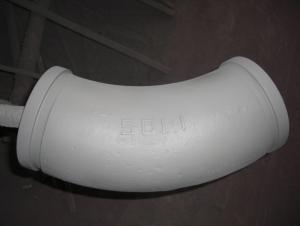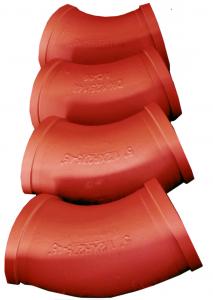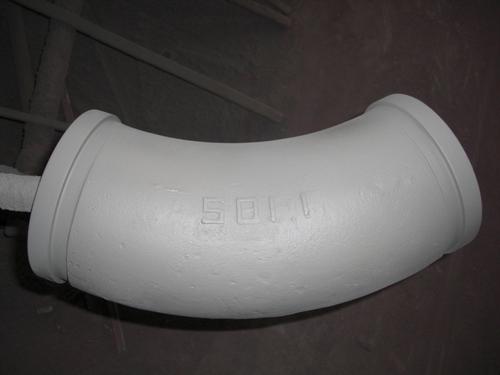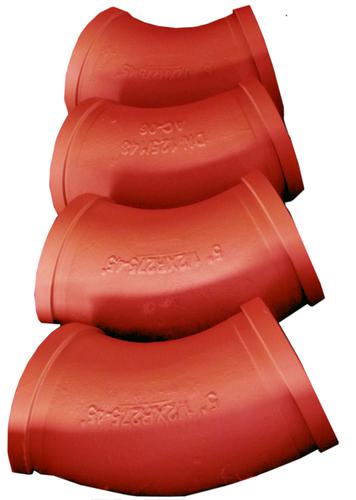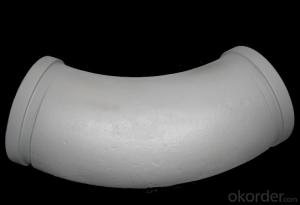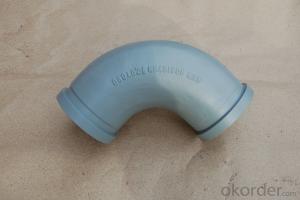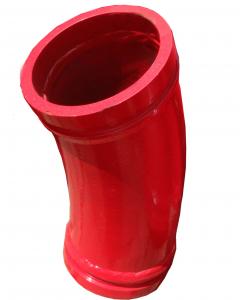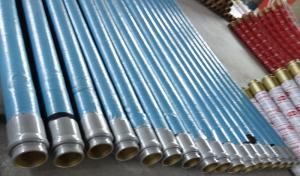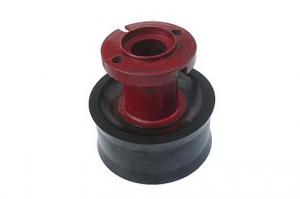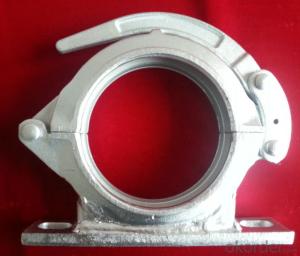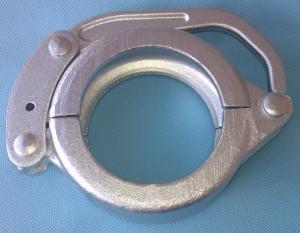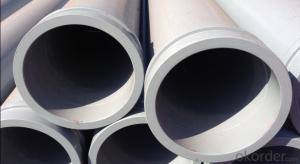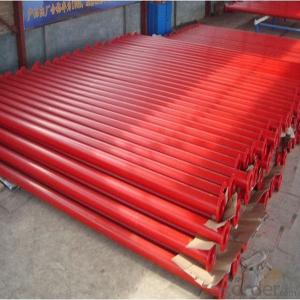Concrete Pump Truck Parts Elbow Bend DN100 R275 45DGR 114.3MM Mn13-4 Casting
- Loading Port:
- China Main Port
- Payment Terms:
- TT OR LC
- Min Order Qty:
- -
- Supply Capability:
- -
OKorder Service Pledge
Quality Product, Order Online Tracking, Timely Delivery
OKorder Financial Service
Credit Rating, Credit Services, Credit Purchasing
You Might Also Like
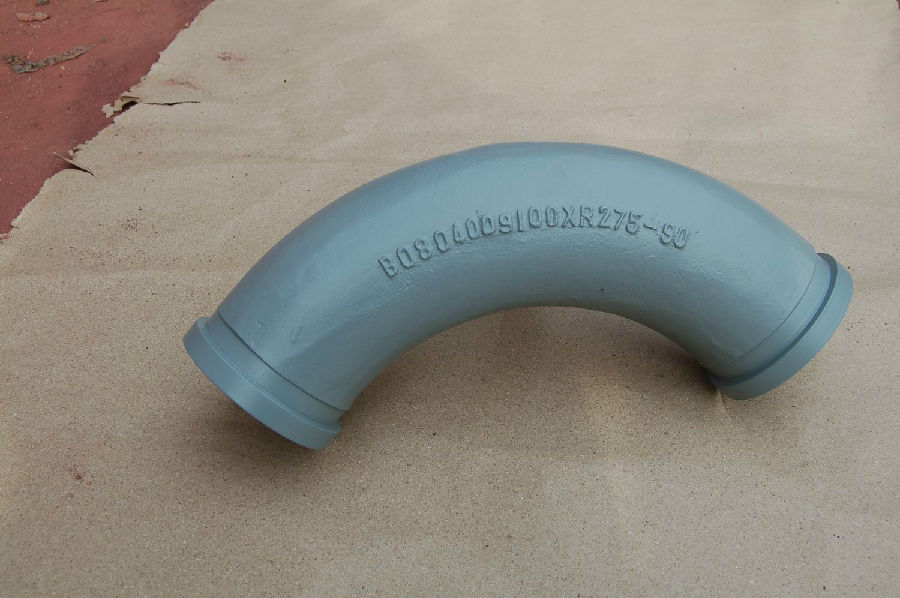
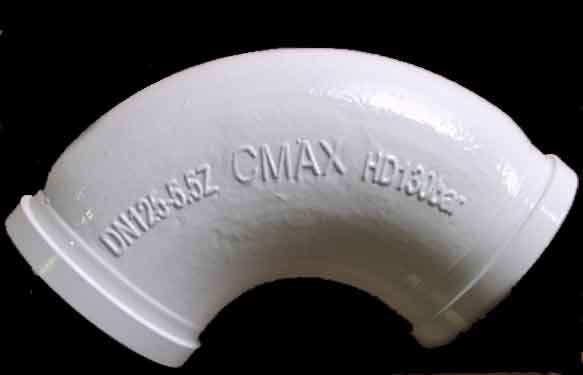
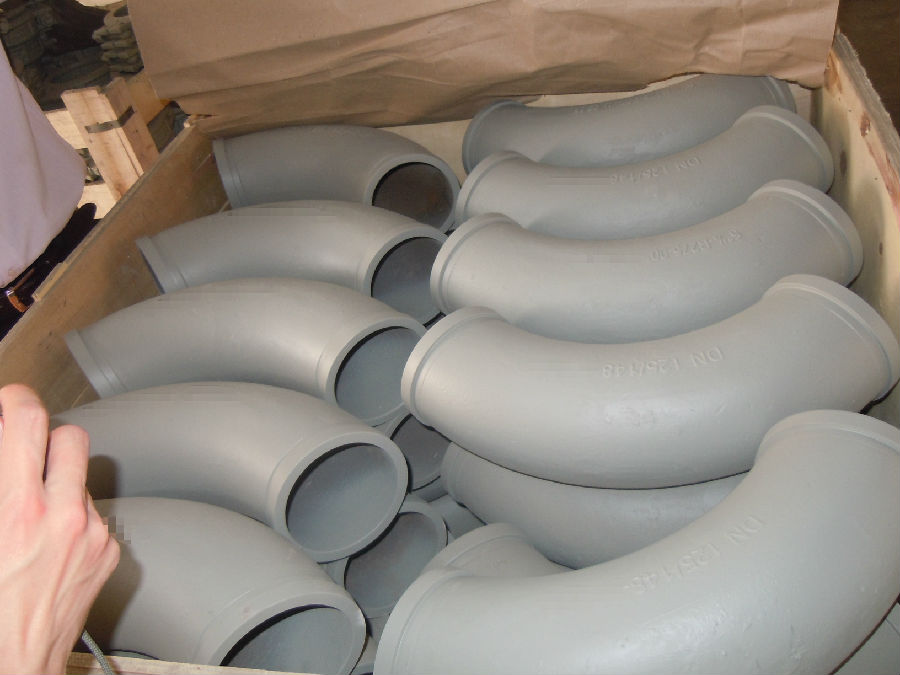
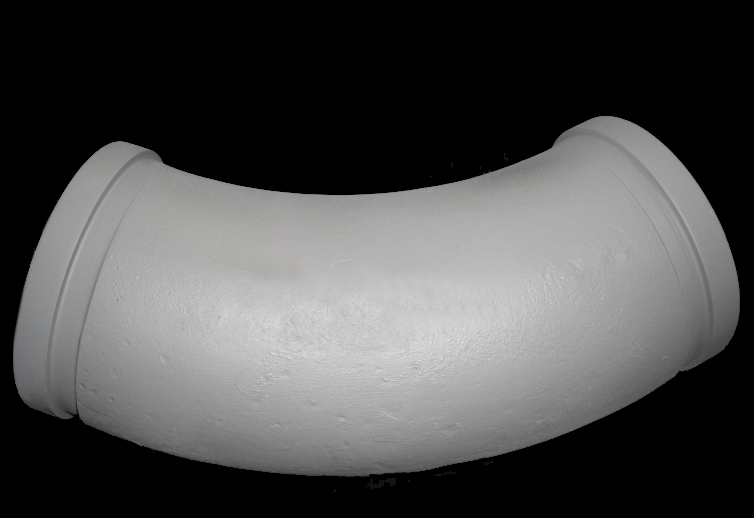
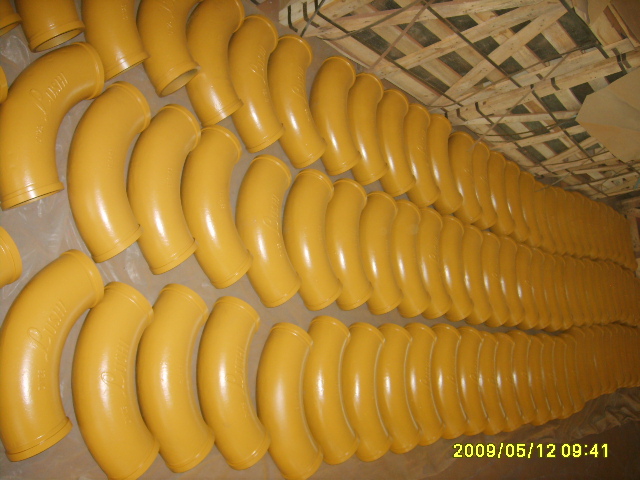
Product Description:
Product Name: Concrete Pump ELBOW DN100
1. Specification of Concrete Pump ELBOW DN100
Dimensions: DN100
Radius: 275mm
Flange: SK, ZX, F&M
Degree: 45
Material: #20 steel, ST52
Thickness: 4.5mm,6mm,7.1mm,7.5mm,10mm,
Working pressure: 180MPa
Notes: total series of concrete pump ELBOW for different brand concrete pump(PUTZMEISTER, SCHWING, CIFA, SANY, ZOOMLION, IHI, KYOKUTO Etc) available from us.
2. Application of Concrete Pump ELBOW DN100
Widely used on concrete pump truck, concrete placing boom, trailer concrete pump etc, for concrete delivery pipe connection.
Our concrete pump bends have been successfully exported to many countries from 1998, Our main markets as below: Middle East, Southeast Asia, America, Brazil, Italy, Russia, South Africa etc
Aiming at the largest concrete pump parts manufacturer, and reliable, professional supplier in China, we can supply concrete pump elbows, delivery pipes, casting or forging couplings, end rubber hoses, rubber pistons, tungsten wear plates, delivery cylinders, and other hydraulic parts, one stop service for your concrete pump parts and accessory business.
3. Package and Delivery of Concrete Pump ELBOW
Every 30pcs put in one seaworthy wooden box, and 20 boxes in one 20feet container.
Product Name: Concrete Pump ELBOW DN100
1. Specification of Concrete Pump ELBOW DN100
Dimensions: DN100
Radius: 275mm
Flange: SK, ZX, F&M
Degree: 45
Material: #20 steel, ST52
Thickness: 4.5mm,6mm,7.1mm,7.5mm,10mm,
Working pressure: 180MPa
Notes: total series of concrete pump ELBOW for different brand concrete pump(PUTZMEISTER, SCHWING, CIFA, SANY, ZOOMLION, IHI, KYOKUTO Etc) available from us.
2. Application of Concrete Pump ELBOW DN100
Widely used on concrete pump truck, concrete placing boom, trailer concrete pump etc, for concrete delivery pipe connection.
Our concrete pump bends have been successfully exported to many countries from 1998, Our main markets as below: Middle East, Southeast Asia, America, Brazil, Italy, Russia, South Africa etc
Aiming at the largest concrete pump parts manufacturer, and reliable, professional supplier in China, we can supply concrete pump elbows, delivery pipes, casting or forging couplings, end rubber hoses, rubber pistons, tungsten wear plates, delivery cylinders, and other hydraulic parts, one stop service for your concrete pump parts and accessory business.
3. Package and Delivery of Concrete Pump ELBOW
Every 30pcs put in one seaworthy wooden box, and 20 boxes in one 20feet container.
- Q: How often should concrete pump hydraulic filters be inspected and replaced?
- Concrete pump hydraulic filters should be inspected and replaced on a regular basis, ideally every 500 hours of operation or according to the manufacturer's recommendations. Regular inspection and replacement of hydraulic filters help ensure the proper functioning and longevity of the concrete pump.
- Q: What are the different types of concrete pump wear rings?
- There are primarily two types of concrete pump wear rings: stationary wear rings and rotating wear rings. Stationary wear rings are fixed in position and provide a surface for the rotating wear ring to slide against. Rotating wear rings, on the other hand, are designed to spin with the impeller and prevent direct contact between the impeller and stationary wear ring, reducing friction and extending the life of the pump.
- Q: What are the potential risks of using non-standard or modified hydraulic components in concrete pump spare parts?
- Using non-standard or modified hydraulic components in concrete pump spare parts can pose several potential risks. Firstly, non-standard components may not have undergone the same rigorous testing and quality control as the original equipment manufacturer (OEM) parts. This means that their performance and durability may be compromised, leading to potential failures or malfunctions. Such failures can result in accidents, injuries, or damage to the equipment or surrounding structures. Secondly, using non-standard or modified components may void the warranty of the concrete pump and its spare parts. Manufacturers typically offer warranties to ensure the reliability and safety of their products. By using non-standard components, the warranty may become null and void, leaving the user responsible for any repairs or replacements needed due to issues arising from these non-standard parts. Another risk is the potential compatibility issues that may arise when using non-standard or modified components. Hydraulic systems rely on precise engineering and compatibility between various components to function optimally. Non-standard or modified parts may not fit properly or may have different specifications, leading to leaks, pressure imbalances, or reduced overall performance. Furthermore, the use of non-standard or modified components may also impact the overall efficiency and productivity of the concrete pump. OEM parts are designed to work seamlessly with the rest of the system, ensuring smooth operation and maximum output. By using non-standard parts, the performance of the pump may be compromised, resulting in increased downtime, decreased productivity, and higher maintenance costs. Lastly, the use of non-standard or modified components may also have legal and regulatory implications. In some jurisdictions, there may be regulations or standards in place that require the use of OEM or certified parts for certain equipment, including concrete pumps. Failure to comply with these regulations can result in fines, penalties, or legal liabilities in case of accidents or failures. In conclusion, the potential risks of using non-standard or modified hydraulic components in concrete pump spare parts include compromised performance and durability, warranty voidance, compatibility issues, reduced efficiency, and legal and regulatory implications. It is always advisable to use OEM or certified spare parts to ensure the safety, reliability, and optimal performance of the equipment.
- Q: How does a hopper agitator motor ensure consistent concrete mixing?
- Consistent concrete mixing is guaranteed with the use of a hopper agitator motor, which is responsible for providing the required agitation and movement within the hopper. By rotating and moving the agitator blades, the motor effectively mixes the concrete ingredients. The main purpose of the hopper agitator motor is to avoid the settling or separation of the concrete during the mixing process. Through its rotation, a swirling motion is generated inside the hopper, ensuring even distribution and thorough blending of all the ingredients. This prevents any formation of clumps or irregularities in the final concrete mixture. Moreover, the motor also aids in breaking up any lumps or clusters that may have formed within the hopper. This action further enhances the uniformity of the mixture, ensuring proper blending of components such as cement, aggregates, water, and additives. Furthermore, the continuous movement of the agitator blades helps in maintaining the desired consistency and homogeneity of the concrete mix. It prevents heavier particles from settling at the bottom of the hopper, ensuring consistent mixture throughout the entire mixing process. In conclusion, the hopper agitator motor is of utmost importance in achieving consistent concrete mixing. Its role includes providing necessary agitation, preventing segregation, breaking up lumps, and maintaining uniformity. The motor's rotational motion and well-designed agitator blades contribute to well-mixed and homogeneous concrete, which is crucial for durable and high-quality concrete structures.
- Q: How do I properly maintain and replace hydraulic pumps in concrete pump spare parts?
- Proper maintenance and replacement of hydraulic pumps in concrete pump spare parts involve a few key steps. Firstly, it is crucial to regularly inspect the hydraulic pump for any signs of wear, leaks, or damage. This includes checking the fluid levels, filters, and hoses. Secondly, following the manufacturer's guidelines, ensure that the hydraulic pump is regularly serviced and that the recommended maintenance tasks are performed on schedule. This includes changing the hydraulic fluid, replacing filters, and lubricating moving parts. Lastly, when it comes to replacing hydraulic pumps, it is important to use genuine and compatible spare parts that are recommended by the manufacturer. Additionally, it is advisable to seek professional assistance or consult the manufacturer's instructions to ensure proper installation and alignment of the new pump.
- Q: What are the fittings of concrete pump?
- Fine stone concrete pump parts are: main oil cylinder, concrete cylinder, three-phase asynchronous motor, main oil pump, hopper, S pipe, electric distribution cabinet, hand oil pump, piston
- Q: What is the function of a concrete pump hopper grate handle?
- The main purpose of a handle on a concrete pump hopper grate is to manually control the opening and closing of the grate. The grate is an essential part of the pump as it allows concrete to enter the pumping system. By using the handle, the operator can adjust the position of the grate in order to control the flow of concrete and prevent any large debris or foreign objects from entering the system. This is crucial for ensuring the smooth operation of the pump and maintaining the quality of the pumped concrete. Additionally, the handle provides easy access to the grate for maintenance and cleaning purposes. Overall, the handle on the concrete pump hopper grate plays a crucial role in regulating the flow of concrete and ensuring the efficiency and reliability of the pumping process.
- Q: Are there any regulatory requirements for the quality and standards of concrete pump spare parts?
- Concrete pump spare parts are subject to regulatory requirements that govern their quality and standards. These requirements are in place to guarantee safety, performance, and durability. These regulations are established by entities such as governmental agencies or industry associations, with the aim of safeguarding consumers and ensuring the proper functioning of concrete pumps. Several common regulatory requirements apply to concrete pump spare parts: 1. Certification: Authorized organizations may certify spare parts or subject them to specific testing processes to verify compliance with quality and performance standards. This certification helps ensure the safety and reliability of the spare parts. 2. Material Standards: Specific material standards may be imposed on spare parts. For example, the materials used in their construction must meet requirements for strength, corrosion resistance, or temperature resistance. 3. Design and Manufacturing Standards: The design and manufacturing processes of spare parts must adhere to certain standards. These standards cover dimensions, tolerances, manufacturing techniques, and quality control procedures in order to ensure consistent and reliable performance. 4. Performance and Compatibility Standards: Spare parts should be designed and manufactured to perform within defined parameters and be compatible with the concrete pump system they are intended for. This guarantees proper and safe functioning of the spare parts when installed in the pump. 5. Documentation and Labeling: Regulatory requirements often mandate that spare parts be accompanied by proper documentation, including user manuals, installation instructions, and maintenance guidelines. Additionally, labeling requirements may exist to clearly identify the spare parts and their specifications. Manufacturers, suppliers, and users of concrete pump spare parts must be aware of and comply with these regulatory requirements to ensure the safety and effectiveness of the concrete pump system.
- Q: How can one source reliable suppliers for concrete pump spare parts?
- To find reliable suppliers for concrete pump spare parts, several steps can be taken. Firstly, conducting comprehensive research on potential suppliers is crucial. This involves searching online directories, industry forums, and construction equipment and spare parts marketplaces. Valuable insights into the reliability and quality of the suppliers can be gained by reading customer reviews and ratings. Secondly, seeking advice and recommendations from experienced industry professionals and experts in the concrete pump industry is advisable. They can provide references for reliable suppliers they have previously worked with. Attending trade shows and exhibitions related to the construction industry is also a beneficial way to connect with suppliers and evaluate their product offerings in person. This allows for direct communication and the opportunity to assess the reliability and quality of their spare parts. Additionally, requesting samples or product catalogs from potential suppliers is essential to ensure that the spare parts meet the required specifications and quality standards. This helps in assessing the reliability of the suppliers and the compatibility of their products with the concrete pump. Furthermore, conducting background checks on the suppliers is crucial. Verifying their credentials, certifications, and licenses provides assurance of their reliability and professionalism. Inquiring about their manufacturing processes and quality control measures is also beneficial to ensure the consistency and durability of the spare parts. Lastly, comparing prices, warranties, and after-sales services offered by different suppliers aids in making an informed decision. Striking a balance between cost and reliability is important to establish a long-term and fruitful partnership. By following these steps and thoroughly evaluating and researching potential suppliers, reliable suppliers for concrete pump spare parts can be sourced. This ensures the smooth operation and maintenance of equipment.
- Q: What are the signs of a faulty concrete pump control panel?
- A faulty concrete pump control panel can be identified through various indicators. To begin with, the control panel not powering on or experiencing intermittent power loss may suggest a faulty electrical connection or a malfunctioning power supply. This can hinder the proper functioning of the panel and its ability to control the concrete pump. Furthermore, error messages or error codes displayed on the control panel may indicate issues with the internal components or sensors. These errors can range from minor malfunctions to more serious problems that require immediate attention. Additionally, an erratic behavior or unresponsive controls of the control panel can be observed. If the buttons or switches do not respond when pressed or behave inconsistently, it could signal a problem with the panel's circuitry or wiring. Moreover, the occurrence of unusual noises or vibrations emanating from the control panel may be a sign of internal mechanical issues. These could include loose or damaged components, faulty relays, or malfunctioning motors. Lastly, if the concrete pump does not perform as expected, it may be attributed to a faulty control panel. Insufficient pressure, incorrect flow rates, or difficulties in starting or stopping the pump can all indicate a malfunctioning control panel. Regardless of the indicator, it is crucial to seek the assistance of a professional technician or the manufacturer for inspection, diagnosis, and repair if there is suspicion of a faulty control panel in a concrete pump.
Send your message to us
Concrete Pump Truck Parts Elbow Bend DN100 R275 45DGR 114.3MM Mn13-4 Casting
- Loading Port:
- China Main Port
- Payment Terms:
- TT OR LC
- Min Order Qty:
- -
- Supply Capability:
- -
OKorder Service Pledge
Quality Product, Order Online Tracking, Timely Delivery
OKorder Financial Service
Credit Rating, Credit Services, Credit Purchasing
Similar products
Hot products
Hot Searches
Related keywords
